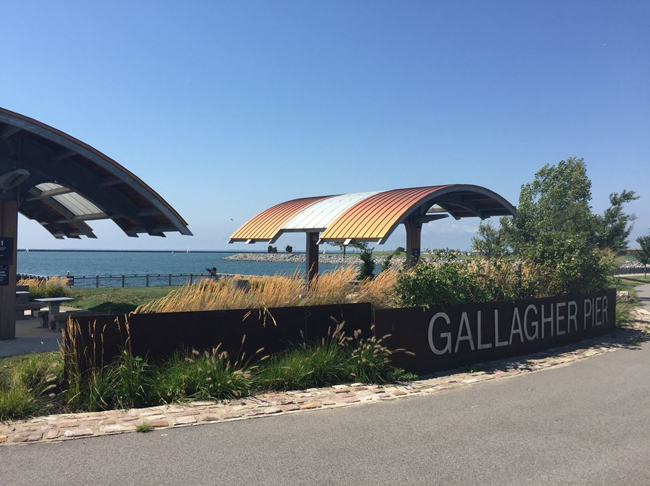
Along Buffalo’s Outer Harbor sits Gallagher Pier and beach-area, a 1400 foot long Lake Erie shoreline property included within Buffalo Harbor State Park. The spot is frequented by wind surfers, kayakers and sun bathers but is currently restricted from use as a swimming beach due to bacteria levels.
— By Chris Gonzales, Communications Specialist, New York Sea Grant
Buffalo, NY, April 25, 2018 – Scientists are tracing a gene called 16S rRNA to pinpoint the sources of bacterial pollution in bodies of water.
Gallagher Pier is 1,400 feet of scenic shorefront that would be ideal for bathing, except for the presence of high bacteria levels. Located near Buffalo, New York, the site is part of the recently established Buffalo Harbor State Park. At present, only watercraft may use the recreational site at the pier. The area is popular with kayakers and windsurfers. Some people still wade in, unaware of the dangers.
New York Sea Grant (NYSG) funded an investigation led by Gary Pettibone and Amy McMillan of Buffalo State College to trace the source of fecal indicator bacterial in the waters around the pier on Buffalo’s Outer Harbor. Since testing in 2013-14, officials have known that the Gallagher Pier area is unsafe for swimming. A 2015 report determined that the location would have been closed for swimming 68% of the days during the season.
A traditional scientific test can tell how severe the presence of bacteria is, but it can’t tell where the bacteria are coming from. That’s where the marker gene 16S rRNA comes in.
The researchers suspected two possible culprits: a 36-inch storm drain near the beach, and a little further away, a ring-billed gull nesting colony. However, they knew bacteria related to fecal matter of human origin are most likely to cause disease in humans.
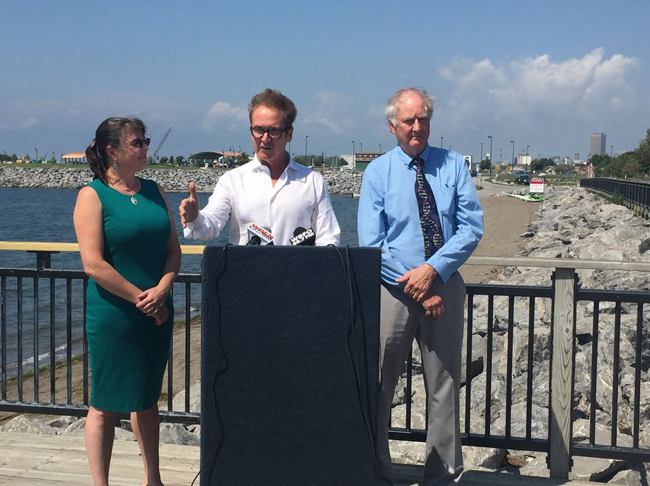
Pictured: (L-R) Buffalo State Associate Professor Amy McMillan, Congressman Brian Higgins and Buffalo State Professor Gary Pettibone, the latter of whom (along with McMillian), led a NYSG-funded Gallagher Pier water quality study. Credit: Office of Congressman Brian Higgins
When the project was launched in August of 2016, Congressman Brian Higgins (NY-26) joined NYSG and its investigators to announce the innovative study.
“With research we hope to isolate the problem and eventually give the public the full-functioning beach they are drawn to,” Higgins said in a press conference at the time.
Pettibone and McMillan analyzed the sequences of 16S rRNA genes found in water samples from various sites near the beach. Comparing the genetic signatures of the bacteria would tell them how closely related the different populations of the organisms were. They collected samples during or after rainfall events to ensure storm water was flowing with enough intensity to mimic real-life conditions. However, overall, it was a rather dry season.
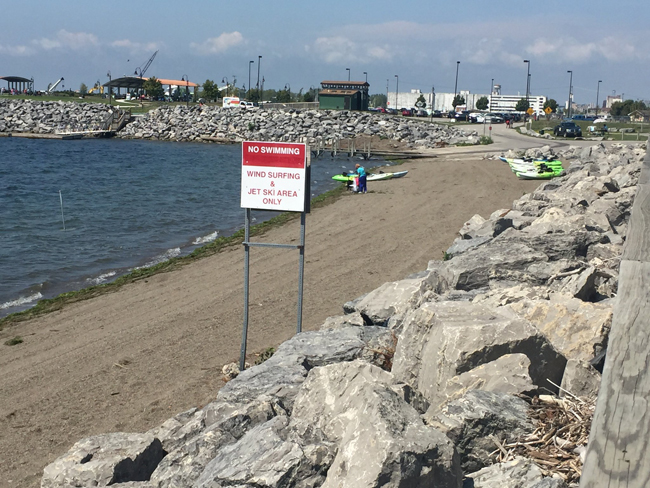
"Gallagher Beach was Western New York’s first waterfront project and we do not need to accept that it is non-swimmable long-term," says Congressman Brian Higgins. Credit: Office of Congressman Brian Higgins
The researchers found, using 16S rRNA gene analyses, that the genetic profile of the bacterial communities around the storm drain were similar to each other, but differed significantly from all other samples. In contrast, the beach area bacterial communities could not be distinguished from other sample sites and there was no clear grouping relating the other sites to the beach area. This means the bacterial species communities in the Gallagher Pier area were similar except near the storm drain. The high levels of bacteria in the beach area, the researchers believe, are influenced from a variety of sources, including bottom sediments near the beach.
The researchers suggest that 16S rRNA gene analysis has the potential to either identify or eliminate suspected fecal pollution sources in environmental studies. The significance of their research is the finding that the storm drain most likely is not the most important contributing factor to the bacterial community near the shore waters and that other sources should be investigated. Furthermore, the researchers wrote that E. coli bacteria count near the gull colony was low in an overwhelming majority of the samples, but that in the future they would like to study additional bird colonies near the harbor entrance that are active earlier in the summer.
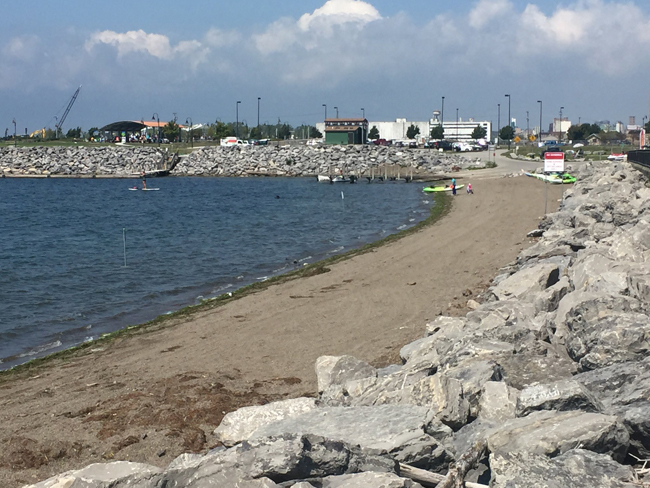
"There is great public demand for swimming at Gallagher Beach. This study funded by New York Sea Grant is first step to solving water quality issue," says Congressman Brian Higgins. Credit: Office of Congressman Brian Higgins
“There is a lot of political and stakeholder interest in what for us is a rather small project,” commented NYSG Director William Wise. “The upshot of this work appears to be that, at least during dry weather, the outfall pipe is not the source of contamination to the pier area.”
DNA tracers seek out contamination sources in Hudson River, too
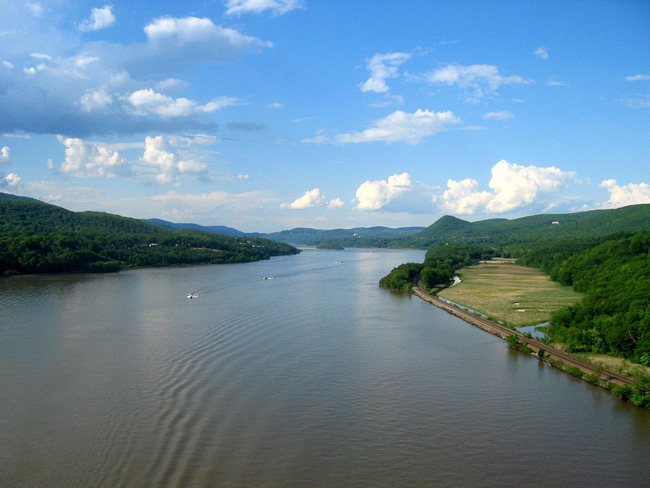
The Hudson River, as seen from the Bear Mountain Bridge.
Another NYSG–funded project, headed by Gregory O’Mullan, Queens College, City University of New York, also used DNA to trace sources of bacterial pollution.
O’Mullan and his team collected water samples in the spring and summer seasons of 2016 and the spring of 2017. In conjunction with Riverkeeper, an environmental organization, and the U.S. Environmental Protection Agency, the investigators tested the Hudson River watershed for fecal indicator bacteria (FIB). They also studied two tracer chemicals, caffeine and sucralose. The caffeine-sucralose ratio turned out to be a good indicator of the presence of untreated sewage. In addition, researchers took DNA samples from the bacteria they found and sequenced its genes.
They tested samples from locations in the Hudson River estuary from New York City all the way to Troy, a distance of approximately 160 miles.
The data demonstrate the potential of the DNA tools to detect location-specific sources of sewage, both treated and untreated. For example, one location contained high levels of fecal and sewer infrastructure core DNA sequences, high levels of chemical tracers, but a low ratio of sucralose to caffeine, and very low ratios of traditional FIB. This is what would be expected of treated sewage.
“By using three different methods of testing, rather than simply testing for presence and severity, the scientists could gather more informative results than they would have by using traditional testing methods,” commented Lane Smith, NYSG’s research program coordinator.
In other areas the scientists sampled, the DNA profiles looked different.
Smith said that the tools need to be refined but provide additional information beyond traditional tests. Most importantly, they give an idea of where the bacteria came from, such as, for example, whether untreated or treated sewage, and the relationships between bacteria collected from different locations.
More Info: New York Sea Grant
New York Sea Grant (NYSG), a cooperative program of Cornell University
and the State University of New York (SUNY), is one of 33 university-based
programs under the National Oceanic and Atmospheric Administration’s
National Sea Grant College Program.
Since 1971, NYSG has represented a statewide network of integrated
research, education and extension services promoting coastal community
economic vitality, environmental sustainability and citizen awareness
and understanding about the State’s marine and Great Lakes resources.
Through NYSG’s efforts, the combined talents of university scientists
and extension specialists help develop and transfer science-based
information to many coastal user groups—businesses and industries,
federal, state and local government decision-makers and agency managers,
educators, the media and the interested public.
The program maintains Great Lakes offices at Cornell University, SUNY
Buffalo, SUNY Oswego and the Wayne County Cooperative Extension office
in Newark. In the State's marine waters, NYSG has offices at Stony Brook
University in Long Island, Brooklyn College and Cornell Cooperative
Extension in NYC and Kingston in the Hudson Valley.
For updates on Sea Grant activities: www.nyseagrant.org has RSS, Facebook, Twitter, and YouTube links. NYSG produces a monthly e-newsletter, "NOAA Sea Grant's Social Media Review," via its blog, www.nyseagrant.org/blog. Our program also offers a free e-list sign up via www.nyseagrant.org/nycoastlines for its flagship publication, NY Coastlines/Currents, which is published quarterly.